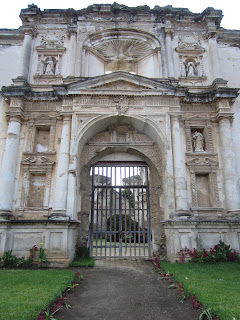The sixth day in Antigua we had our two classes at the Casa. We changed our class schedule on this day to set up a more flowing daily schedule. We now have history from 9-10:30 and religion from 11-12:30, which changes mine and Gloria's lunch to 1pm, but makes the whole afternoon more open.
Our homework for our history class was a reading called "Antigua Tipica Markets and Identity Interaction" by Little from Mayas in the Marketplace. The reading "addresses how life and selling in a marketplace contributes to vendors' various expressions of collective identity" (pp89-90). By looking at the marketplaces in Antigua one is learning about the interactions between the indigenous, Ladinos, and tourists as well as their assumed place in the design of Antigua. There are two kinds of markets that happen in Antigua: periodic and tipica. In a periodic marketplace the consumers are local and return often to the market. The tipica marketplace is for tourist consumers or consumers who rarely return. The article explores the relationships between the tourists and the indigenous at the tipica market, the indigenous and Ladinos at the tipica markets and periodic markets, the tourists and Ladinos at the periodic market, and the tourists assumptions about the vendors at both market types. The article raised a lot of questions and observations for myself and the other students about the situations in the marketplaces and on the streets. I was warned about prejudices that exist in Antigua and all of Guatemala, but this article placed the issues in a locale in which we students can see everyday while studying here.
This reading led me to look more closely at what I had learned about huipils back in March. Huipils are embroidered with symbols and colors that indicate the place and family groups/tribes that the indigenous people come from. In modern times however, many indigenous no longer follow the traditions of wearing the colors and symbols of their homes. Some wear huiplils strictly for fashion while others wear different huipils to protect themselves.
In class we discussed the reading, and even touched on the modernization of the huipil. We then had a lecture on the key theological concepts of Maya religion and the Maya sacred scripts which still exist in one form or another today. We also did a quick historical look at Spain, which puts into context the actions of the conquest and what led up to it.
In religion class we watched a 1983 documentary called When the Mountains Tremble directed by Newton Thomas Sigel and Pamela Yates, and narrated by Rigoberta Menchu. The movie is a very close look at the war between the Guatemalan Military and the Maya indigenous population. The documentary looks from both the military side, following the soldiers and interviews with generals, and the indigenous rebels, following the guerrillas in hiding and interviews with Maya people being repressed by the military. The film was also narrated by Rigoberta Menchu, who told her own personal family history with the war in graphic detail. The documentary also shows the violent results of the military repression in Maya towns by showing footage of Maya people murdered by soldiers in too different places; one person is one town and a group of people in a village. The did not end until 1996, 13 years after the documentary was released. Class ran over our normal time so we did not have time to discuss the film, but outside of class all the students talked about its effect on us and the information we learned.


No comments:
Post a Comment